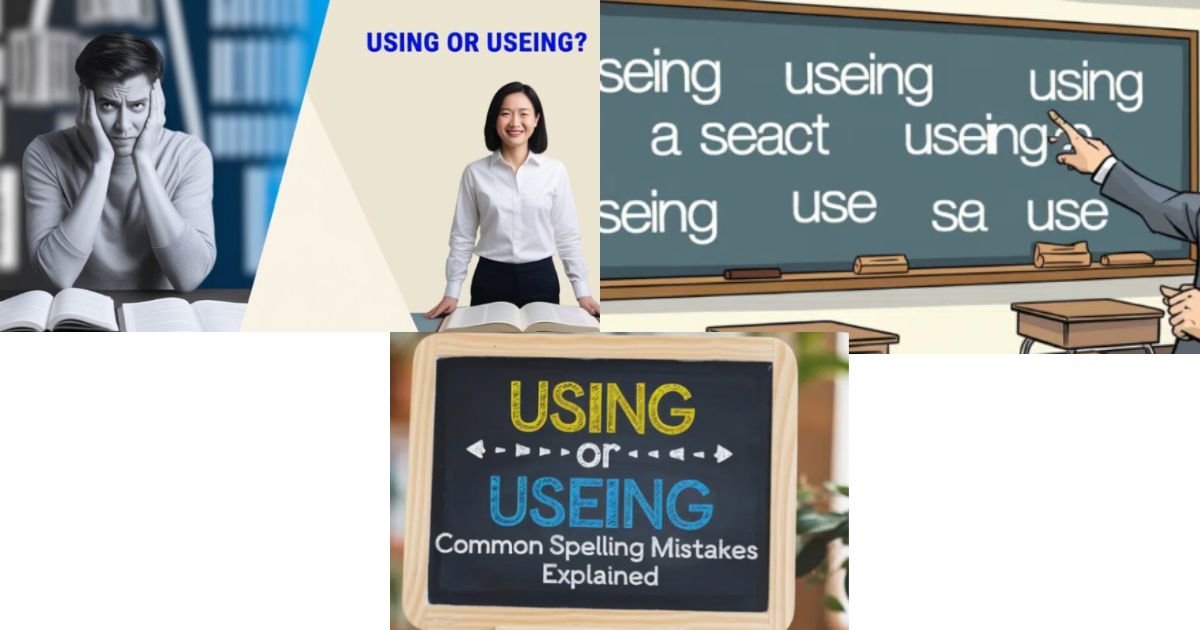“Using” is the correct way to spell the present participle of the verb “use,” meaning to employ or apply something for a purpose.
It’s a simple word we rely on every day, yet many people mistakenly write “useing” by adding an unnecessary “e.” Sound familiar?
This mix-up often happens because English spelling rules can feel tricky at times. But here’s the good news: once you know the rule, you’ll never make the mistake again.
Want to keep your writing sharp and error-free? Let’s dive into why “using” is right and “useing” isn’t!
Understanding Using or Useing
“Using” is the correct form and is the present participle of the verb “use.” It describes the action of employing something for a particular purpose. For example, when someone says, “She is using a pen to write,” they are applying the correct spelling rules. In contrast, “useing” is an incorrect spelling that does not follow English grammar guidelines.
The typographical error of “useing” often arises from a misunderstanding of spelling rules. Some writers mistakenly add an extra “e” when forming the present participle of “use.” This common spelling mistake can undermine writing clarity and distract readers. To avoid this, writers must understand grammar rules and apply spelling tips to double-check their work.
Using: Definition and Usage
“Using” is a versatile word that communicates ongoing actions or processes involving the employment of something. It is derived by adding the “-ing” suffix to the base verb “use,” adhering to English spelling rules. Correct usage of “using” ensures effective communication and enhances writing clarity.
Correct Usage of “Using”
When employing “using” in sentences, it describes the act of utilizing, applying, or leveraging tools, strategies, or resources. For instance, “I am using my computer to complete this task” highlights its role as an action verb in describing ongoing actions. Writers can also enrich their language by incorporating synonyms for “using,” such as employing, applying, or operating, to add variety and depth.
Useing: Definition and Usage
“Useing” is a misspelling of “using” and violates the standard grammar rules of English. Adding an unnecessary “e” disrupts the correct form of the present participle. Recognizing and correcting such errors is crucial for maintaining professional writing standards and language consistency.
Why “Useing” Is Incorrect
The misspelling of “useing” stems from confusion over similar-looking words like “hope” (hoping) or “come” (coming). However, in “use,” the “e” is dropped before adding “-ing.” Misspelling examples like “useing” undermine grammar guidelines and harm writing clarity, making it essential to double-check writing for such common errors.
Side-by-Side Comparison: Using vs. Useing
A clear understanding of the differences between “using” and “useing” helps avoid mistakes. The table below highlights their distinctions:
| Aspect | Using | Useing |
|---|---|---|
| Definition | Present participle of “use” | Incorrect spelling |
| Spelling Rules | Follows English grammar guidelines | Breaks grammar guidelines |
| Example | “They are using a new app.” | “They are useing a new app.” |
| Grammar Guidelines | Correct | Incorrect |
Everyday Usage Examples of “Using”
Correctly using “using” in sentences enhances writing clarity. For instance, “She is using her phone to send a message” demonstrates the proper application of the word. Similarly, “They are using advanced tools to analyze data” showcases its versatility in describing ongoing actions.
These examples highlight the importance of adhering to grammar rules to ensure effective communication. Writers should strive to incorporate action verbs like “using” accurately to convey their intended meaning clearly.
Everyday Usage Examples of “Useing”
The misspelling “useing” can appear in informal writing but should be avoided in professional contexts. For example, writing “She is useing a laptop for her project” is incorrect and disrupts the flow of language. Instead, use the correct form: “She is using a laptop for her project.”
By avoiding such common blunders, writers can enhance their language consistency and ensure their message remains professional and clear. Adhering to grammar guidelines and spelling tips will help eliminate typographical errors and maintain high writing standards.
FAQs
Why Is “Useing” Incorrect?
“Useing” is incorrect because it breaks the rule of dropping the silent “e” before adding “-ing.” The proper spelling is “using.”
What Is the Correct Way to Spell “Using”?
The correct spelling is “using.” To form it, take the verb “use” and simply add “-ing,” without adding an extra “e.”
How Can I Avoid Spelling Mistakes Like “Useing”?
To avoid errors, remember this simple rule: drop the silent “e” from verbs ending in “e” before adding “-ing.” For example:
- Use ➔ Using
- Hope ➔ Hoping
Conclusion
In conclusion, the correct spelling is using, not useing. Adding an extra “e” to the word is a common mistake. To form the present participle, simply add “-ing” to the verb use without the extra “e.”
By following this simple rule, you can avoid spelling errors like useing. Always remember to drop the silent “e” when adding “-ing” to verbs like use. This small step will help improve your writing.
Read Also
Annual or Anual: What’s the Difference?
Successfully Or Succesfully: Which One Is Correct and Why?
Chosing or Choosing: What’s The Difference?

Amelia – is a language lover, specializing in spelling, idioms, phrases, and metaphors, making complex concepts simple and fun.
